Join the Club
Join our email list and get access to specials deals exclusive to our subscribers.
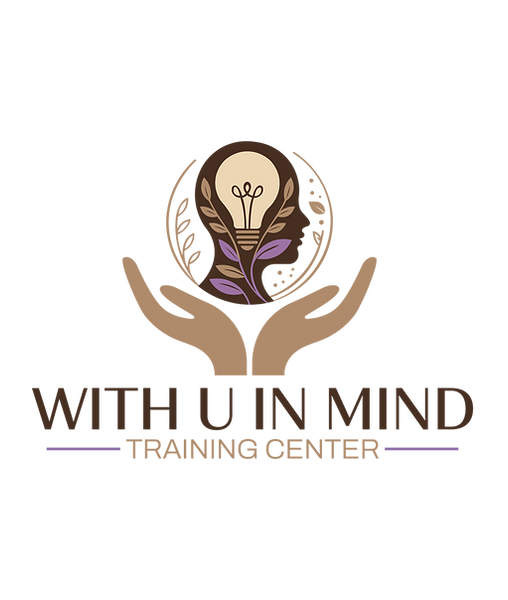
Owner/Instructor
Elder Deborah Simon
By Appointment Only
Contact Information
(919)438-1037
About The Owner/Instructor: Deborah Simon has dedicated over 19 years to clients as a certified nursing assistant. Her extensive experience spans hospice care, skilled nursing homes, memory care units, assisted living facilities, and home health services As a former AHA Instructor and current American Red Cross instructor she is passionate about teaching and mentoring, including her role as a marriage mentor/ facilitator with SMYBIS. Additionally, she specializes in positive parenting, guiding parents through challenges with their children from infancy to middle school using Postive Parenting Program though Triple P Postive Parenting Curriculum. Deborah Simon also has a passion for training,empowering and equipping caregivers with the necessary skills and support to keep their loved one's home in a safe, stable and nurturing environment enviroment.


Welcome to With U In Mind Training Center LLC! We specialize in First Aid, CPR, and AED training for adults, infants, and pediatric individuals. Our courses also cover vital topics such as Bloodborne Pathogens, emergency preparedness, and recognizing emergencies in various settings like workplaces and schools. Additionally, we offer skill-boosting classes focused on asthma, anaphylaxis, opioid overdose, and more, helping teenagers gain the confidence and skills they need to respond effectively in emergencies while baby sitting. We also offer training on caring for loved one's at home
Our mission is to train,, and equip caregivers, providers, and organizations within the community. We strive to provide the necessary skills, support, and confidence to deliver quality care in diverse settings and situations. Together, we can enhance the standard of care and ensure that every individual receives the attention and compassion they deserve.
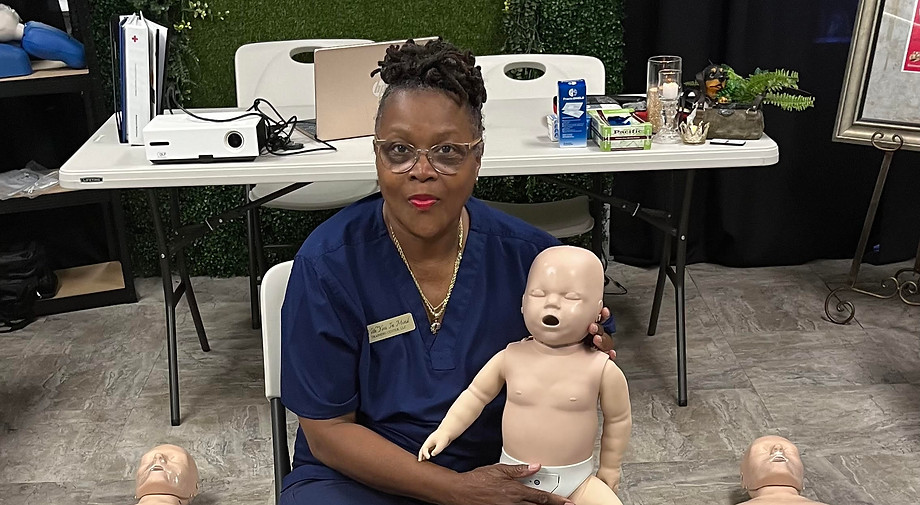
Training Center


At With U In Mind Training Center LLC, we provide top-notch mankins for confident practice. Our mankins feature three different light settings to enhance your depth perception during training sessions.
Quality Mankins
Call The Village Our Gold To train empower and equip caregivers, provider and organization in the community with the necessary skills, support and confidence to provide quality care in diverse setting and situations

Lesson Topic's/ Program Purpose And Program Objectives

1
Lesson Names and Topics
ADULT CPR
Total Time 2 Hours, 10 Min
Lesson 1: Before Giving Care and Checking an Injured or Ill Person
Time: 66 Minutes
Lesson 2: Cardiac Emergencies and Giving CPR Skill Session Adult
Time: 30 Minutes
Lesson 4: Choking Skill Session Adult
Time: 14 Minutes
Lesson 8: Conclusion
Time: 20 Minutes
Price $75.00 Per Student
2
Program Purpose:
Program Purpose:
To Provide Participants and Caregivers with the knowledge and skills they need to recognize and respond appropriately to cardiac, breathing and first aid emergencies the courses in this program teach participants the knowledge and skills needed to give immediate care to an injured or ill person and to decide whether advanced medical care is needed. This program offers a choice of first aid, CPR and AED courses to meet the various training of a diverse audience
3
Lesson Objectives
Lesson Objectives
After Completing This Lesson, Participants will Be Able To:
Recognize the signs and symptoms of a heart attack
Describe first aid care for a heart attack
Explain how cardiac arrest differs from a heart attack
List causes of cardiac arrest
Describe the links of the Cardiac Chain of Survival
Demonstrate how to perform CPR
Explain what to do if the chest does not rise with rescue breaths
Describe how to perform compression-only CPR, and explain when it is appropriate to perform compression-only CPR
Programs Curriculum Outlining

1
RECOGNIZING CARDIAC ARREST
Cardiac arrest occurs when the heart stops beating or beats too ineffectively to circulate blood to the brain and other vital organs.
Cardiac arrest frequently happens suddenly, without any signs and symptoms
Cardiac arrest is often due to a blockage of the blood vessels supplying oxygen to the heart muscle (heart attack)
If you think a person is in cardiac arrest: Call 9-1-1 and get equipment or tell someone to do so and begin CPR immediately. Used an AED as soon as possible.
2
SIGNS AND SYPTOMS OF A HEART ATTACK
A heart attack occurs when blood flow to part of the heart muscle is blocked for example, as a result of coronary artery disease. Because the cells in the area are not receiving the oxygen and nutrients they need, they die, causing permanent damage to the heart muscle.
Seeking advanced medical care as soon as the signs and symptoms of a heart attack are recognized can minimize damage to the heart and may save the person's life
3
BEFORE GIVING CARE AND CHECKING AN INJURED OR ILL PERSON
The purpose of this course is to teach participants to recognize and respond appropriately to cardiac, breathing and first aid emergencies. There are four actions you can take to make a difference in the outcome for the injured or ill person. These actions are
Recognizing that an emergency exist.
Deciding to take action.
Activating the emergency medical services (EMS) system.
Giving care consistent with your knowledge and training until EMS personnel arrive and take over.


Description Of Class And Video Segments And Timings

1
Lesson Names and Topics
Lesson 1: Before Giving Care and Checking an Injure or Ill Person. (time: 66 Minutes)
Lesson 2: Cardiac Emergencies and Giving CPR Skill Session Adult.(time: 30 Minutes)
Lesson 4: Choking Skill Session Adult.(time: 14 Minutes)
Lesson 8: Conclusion. (time: 20 Minutes)
CLASS SIZE (PARTICIPANTS TO INSTRUCTOR RATIO (
Class Price $75.00 per person
2
Adult CPR Courses / Video Segments Times
Lesson 1: You Can Make A Difference (ADULT) ( 1:48) Minutes
CHECK-CALL-CARE(ADULT) (2:40) Minutes
Checking a Responsive Person (ADULT) (3:46) Minutes
Lesson 2: Signs and Symptoms of a Heart Attack (ADULT) (1:43) Minutes
The Cardiac Chain of Survival (ADUTL) (1:55) Minutes
Giving CPR (ADULT) (2:03 ) Minutes
3
Adult CPR Courses / Video Segments Times
Lesson 4: Choking / Recognizing Choking (ADULT) (0:59) Minutes
Caring For Choking (ADULT) (1:27) Minutes
Giving CPR: Practice While You Watch (Adult/Child) ( 2:45) Minutes
If The Chest Does Not Rise With Rescue Breaths (ADULT) (0:57) Minutes
Total Time 2 hours, 10 Minutes
Adult CPR Course Time:
TRAINING

1
Learning Objectives/ Equipment And Supplies
Learning Objectives: After completing this module, participants will be able to: Recognize when a responsive adult is choking, Demonstrate how to care for an adult who is responsive and choking. Describe how to care for an adult who becomes unresponsive.
Materials, Equipment and Supplies:
Adult First Aid/CPR/Instructor-Led Training course presentation, videos
Latex-free disposable gloves/ Skill Practice Sheets/Giving Back Blows and Abdominal Thrusts to Adults. Adult/Mankins Training AED Training equipment Latex-free disposable gloves (Multiple Sizes)
Assessment Scenario Flowchart/Ready Reference Cards (optional)
2
If The Chest Does Not Rise With Breaths
There are three reasons why the person's chest may not rise when you give rescue breaths: the airway was not opened properly. The person's nose and mouth were not properly sealed. An object is blocking the airway.
If the first rescue breath does not cause the chest to rise, re-tilt the head to ensure that the person's nose and mouth are properly sealed before giving the second rescue breath. after giving second breath does not make the chest rise a object may be blocking the person's airway. never attempt more than 2 rescue breaths between sets of compression Immediately begin the next set of chest compressions. the chest compressions may force the object out of the person's airway. After the set of compressions and before giving rescue breaths, open the person's mouth, look for an object in the mouth and if you see it, remove it.
To remove an object that you see in the person's mouth, do a finger sweep using your index finder (for an adult) or your little finger (for a child or infant)
3
Choking Skill Session Adult
Instructor will Discuss all points in the topic, Recognizing Choking, Show video, Recognizing Choking. (Adult) (1:39)
Discuss all points in topic, Caring for a Choking Adult
Show the video caring for responsive choking Adult (3:12)
Show the video caring for unresponsive choking Adult (1:30)
Conduct the skill practice, giving back blows and abdominal thrusts to Adults
Discuss all points in the topic, assessment scenario: caring for a choking Adult.
Conduct the scenario, caring for a choking Adult
WHAT HAPPENS IF THE CHEST DOESN'T RISE

TRAININGS
Lesson 2: Cardiac Emergencies and Giving CPR Skill AED
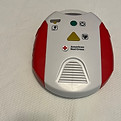
Adult First AID/CPR/AED
This program will provide participants with knowledge and skills they need to recognize and respond appropriately to cardiac, breathing and first aid emergencies.
The courses in this program teach participants the knowledge and skills needed to give immediate care to an injured or ill person and to decide whether advanced medical care is needed.
This program offers a choice of First Aid/CPR/AED courses to meet the
various training needs to a diverse audience
Price $100.00

program Objectives
Describe how to recognize and emergency and gain confidence to act.
Explain how to lower the risk for infection when giving care.
Describe the emergency action steps: CHECK-CALL-CARE.
Call 9-1-1 or designated emergency number.
Explain how to check an injured or ill person
Recognize the signs and symptoms of the following sudden illnesses.
Shock, Asthma Attack, Anaphylaxis, Heart Attack, Opioid Overdose, Diabetic Emergencies, High Fever, Vomiting, diarrhea and Dehydration.
Demonstrate how to control life-threatening bleeding by direct pressure and application of a commercial tourniquet.
Recognizing the following injuries and illnesses: burn, head, neck and spinal injuries, concussion, heat stroke, hypothermia, poison exposure.

Cardiac Emergencies
CRDIAC ARREST OCCURS WHEN THE HEART STOPS BEATING OR BEATS TOO INEFFECTIVELY TO CIRCULATE BLOOD TO THE BRAIN AND OTHER VITAL ORGANS
Cardiac arrest is often due to a blockage of the blood vessels supplying oxygen to the heart muscle (heart attack) Cardiac arrest may also occur due to effects of: Drowning, Breathing Emergencies, Trauma.
A person in cardiac arrest is not responsive, not breathing or only has gasping breaths and has no heartbeat.
By acting right away you make a difference and save a life by giving CPR if you think a person is in cardiac arrest:
You should call 9-1-1 or have someone call and get equipment if available and begin CPR immediately and as soon as possible use an AED
TRAININGS
Using AED Skill Adult Safe and Effective Use of AEDS
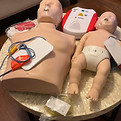
Using AED
For someone in cardiac arrest, deciding to act is the most important First step. Calling 9-1-1 and getting equipment, or telling someone to do so, Starting CPR immediately and using AED AS SOON AS POSSIBLE GIVES THE PERSON THE BEST CHANCE FOR SURVIVAL.U
Use the AED as soon as possible, but do not delay compressions to A person must be removed from water (puddle or body of water) before using the AED. It is safe to use an AED on pregnant women, in rain and snow, and when the person is lying on a metal surface.
An AED is also safe to use on a person with an implantable medical device (pacemaker) but the AED pads should not be placed directly over the device.
It is not necessary to shave a person's chest hair before applying the AED pads no remove jewelry or piercings before using the AED
We will watch a video about using an AED for ADULTS (6:12Min)
Assessment Scenario Walk-Through Video (1:48 Min)
Assessment Scenario: Giving CPR and Using an AED (15:00 Min)
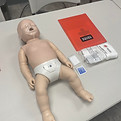
Lesson 4: Choking Skill Adult
After completing this module, participants will be able to recognize when a responsive adult is choking, demonstrate how to care for an adult who become unresponsive topic covered: Recognizing Choking.
Video Recognizing Adult Choking (1:39 min)
Video Caring for unresponsive Choking Adult (1:30 min)
Discuss all points in topic Assessment Scenario: Caring for a Choking Adult.
Conduct the scenario, Caring for a Choking Adult.
Conduct the skill practice, Giving Back Blows and Abdominal Thrusts to Adults
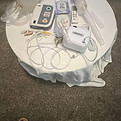
Lesson 5: Sudden Illness Topic and Video Covered
Topic covered: Sudden Illness, Recognizing and Caring for Sudden Illness.
Videos: General Approach to Sudden Illness (Adult) (2:38 min)
Videos: Adult Stroke (1:48 min)
Videos: Adult Asthma Attack (1:10 MIN)
Videos: Anaphylaxis (1:23 min)
Videos: Adult Heart Attack (2:13 min)
Videos: Adult Opioid Overdose (1:10 min)
Videos: Adult Diabetic Emergency (1:47 min)
Instructor Lead: Scenario Caring for a Person with a Sudden Illness (optional)
Training
Lesson 5

Sudden Illness Learning Objectives
After completing this module, participants will be able to identify
Recognize a sudden illness
Describe general care for common sudden illnesses
Describe how to assist an adult with medication

Lesson 6: Life-Threatening Bleeding Injuries
Instructor will discuss all points in the topic Recognizing Life-Threatening Bleeding
Show Video, Recognizing Life-Threatening Bleeding (0:50 min)
Discuss all points in the topic, Caring for Life- Threatening Bleeding
Video Using Direct Pressure to Control Life-Threatening Bleeding (Adult 9:16 min)
Conduct skill practice, Using Direct Pressure to Control Life-Threatening Bleeding
Discuss all points in the topic, Assessment Scenario Caring for Life-Threatening Bleeding
Conduct the scenario, Caring for Life-Threatening Bleeding

Learning Objectives Materials, Equipment / Supplies
After completing this Lesson: participants will be able to: Recognize Life-Threatening Bleeding
Demonstrate how to control Life Threatening Bleeding
Explain how to control life-Threatening Bleeding
Materials, Equipment and Supplies: Student Training Kits for CPR/AED
Latex-free disposable gloves (multiple sizes) Gauze pads Roller bandages
Sill Practice Sheets/ Assessment Scenario Flowchart/ Participant's Progress Log
Training
Lesson 7
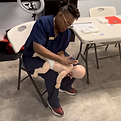
Injuries and Environmental Emergencies
INSTRUCTOR Lead Topic: Injuries and Environmental Emergencies (10:00 min)
Videos (Adult) Burns 2:01 Min)
Videos (Adult) Head, Neck and Spinal Injuries (2:53 Min)
Videos (Adult) Heat Stroke (1:10 min)
Videos (Hypothermia (1:10 min)
Videos (Adult) Poison Exposure (1:14 Min)
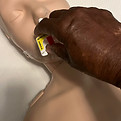
Lesson 7: Learning Objectives and Materials
After completing this lesson participants will be able to:
Recognize and respond to common injuries, including burns and head, neck and spinal injuries.
Recognize and respond to environmental injuries, including heat stroke, hypothermia and poison exposure.
Materials, Equipment and Supplies
Instructor-Led training course presentation
Videos on injuries and Environmental Emergencies
Ready Reference Cards (optional)
First/ AID/CPR/AED Participant's Manual (optional)

Lesson 7: Conclusion/ Learning Objective/ Materials
To complete this lesson and the learning objectives participants must take final exam (optional) depending on the need for certificate
Learning Objective: after completing this lesson participants will be able to / pass the final exam (optional) depending on the need for certificate
Receive a digital certificate after successfully meeting the requirements for course completion
Materials, Equipment and Supplies: Instructor-Led Adult First Aid/CPR/AED Training course presentation, Videos, Final Exams (optional) Instructor Evaluation forms participants names (optional)

Our training Basic Life Support (BLS)

1
BLS Blended learning
Basic Life Support Blended Learning course provides participants with the knowledge and skills they need to assess, recognize and care for patients who are experiencing respiratory arrest or respiratory failure, cardiac arrest, airway obstruction, opioid overdose or other life-threatening injury or illness. when a patient experiences a life-threatening emergency. healthcare providers need to act swiftly and promptly. the course emphasizes providing high-quality care and integrating psychomotor skills with critical thinking and problem solving to achieve the best possible patient outcomes
2
Course Objectives
After completing this course, participants will be able to:
Apply concepts of effective teamwork when caring for a patient experiencing a life-threatening emergency.
Integrate communication, critical thinking, and problem- solving skills during a high- performance BLS team response.
Apply a systematic, continuous approach to assess, recognize and care for adults, children and infants experiencing a life- threatening emergency.
Perform a rapid assessment for responsive and unresponsive adults, children and infants
Identify BLS differences among adults, children and infants
State the principles of caring for a pregnant patient in cardiac arrest
State the principles of caring for a patient experiencing an opioid oversose
3
Course Delivery Methods
There are two delivery methods for the Basic Life Support program:
An instructor-led course
A blended learning course with an online session and in-person skills session conducted by a certified instructor
Course Instructional Design
As the first part of the blended learning course, the online session is designed to instruct participants in the knowledge-based aspects of the course and introduce them to the skills they will practice and master during the in-person skills session.
The in-person skills session focuses on hands-on skill practice and scenario-based team response practice and testing
Basic Life Support (BLS) Course Information

1
BLS Course Topic, Times
Course Lengths and Schedules
The online session of the (BLS) Blended Learning course is designed to be adaptive, Depending on the participants. The online session can take between 45 minutes. to 2.5 hours post-assessments and final exam session is approximately 90 minutes
2
BLS IN- PERSON SKILL SESSION
The in-person skill session is designed to be taught in approximately 2.5 hours, including administering the Team Response Final Scenarios
A participant-to- instructor ratio of 9:1
3
Course Purpose
The in-person skill session is to review key points learned during the online session, practice basic life support skills, and demonstrate skill competency during a team response. to help improve patients' outcomes, they will learn to: further develop critical-thinking and problem-solving skills
Basic Life Support Training

1
Basic Life Support for Adults Lesson 2
Lesson Length 60 Minutes
Rapid Assessment for Adults (10) Minutes
Life-Threatening Injury or Illness in Adults (5) Minutes
Respiratory Arrest of Failure in Adults (5) Minutes
Components of High-Quality CPR (30) Minutes
BLS Team Response for Adults
Practice Scenario: BLS for Adults (10) Minutes
2
Basic Life Support for Children and Infants
Lesson Length (45) Minutes
Differences Among Adults, Children and Infants (15) Minutes
High-Quality CPR for Children and Infants (15) Minutes
AED Use for Children and Infants (5) Minutes
BLS Team Response for Children and Infants (10) Minutes
3
Obstructed Airway Adults, Children and Infants Lesson 4
Obstructed Airway Care for Responsive Adult and Children (8) Minutes
Obstructed Airway Care for Responsive Infant (5) Minutes
Obstructed Airway Care for Unresponsive Adult, Children and Infant (2) Minutes
Our Babysitter Training

1
Being the Best Babysitter in the Game Lesson (1) 60 Minutes
Welcome/ Introduction to Babysitter's Training/ General Information and Ground Rules / Health and Safety Precautions/ Course Delivery/ Course Completion Requirements/ New Faces, New Friends/ Set Up Activity/ Do Activity/ Share Answers/ What It Means to Be a Good Babysitter/ Exploring Leadership Skills/ Do Activity/ Share Answers/ Leadership Styles/ Using the Decision- Making Model/Epic Battle Set Up Video-Based Guided Discussion/ Do Video-Based Guided Discussion/ Solution Sleuth Set Up Activity/ Do Activity/Share Answers/ Important Considerations/ Rules and Expectations Set Up Activity/Do Activity/ Share Answers/ Marketing Yourself/ Safety First Discussion/ Do Guided Discussion/ Interviewing Potential Clients/ Is The Job Right for You/ Doing Stand Up, Sit Down Activity/ Let the Adventures Begin/ Lesson 1 Wrap-up
2
Staying Safe on the Job Lesson 2 (50) Minutes
Putting Safety First/ Unexpected Visitor Video- Based Guided Discussion/ Spotting Potential Safety- Related Problems/ Hazard Hunt Set Up and Do Activity/ Share Answers/ Accidents Can Happen Anytime, Anywhere/ Toddler on the Run Set Up and Do Guided Discussion/ Wacky Word Adventure Set Up and Do Activity/ Share Answers /Staying Safe During Bad Weather and Natural Events/ Fire Safety Set Up and Do Based Guided Discussion/ Water Safety Set Up and Do Based Guided Discussion/ Lesson 2 Wrap-Up
3
Caring for Children and Infants from Mealtime to Bedtime Lesson 3 (60) Minutes
Aes, Stages and Milestones/ Basic Child Care/ Stopping the Spread of Germs/ Hand Washing Practice/ Set Up Do and Wrap up Skill Practice/ Using Latex-Free Disposable Gloves/ Removing Gloves Set Up Do and Wrap Up Skill Practice/ Lifting, Moving and Comforting/ Picking Up and Holding do, and Wrap Up Skill Practice/ Bottle-Feeding Set Up Do and Wrap Up Practice/ Spoon- Skill Set Up, Do and Wrap Up Sill Practice/ Taking Charge of Diaper Duty Skill Set Up, Do and Wrap Up Skill Practice/ Handling Bedtime Why Sleep Matters Set Up, Do Guided Discussion/ Tips for a Smooth and Safe Bedtime/ Lesson 3 Wrap-Up
Our Babysitter Training

1
Playing and Promoting Positive Behavior Lesson 4 (25) Minutes
Play: It's A Tough Job/ Play is a Big Part of Babysitting Play, Do and Share Video Set Up Activity/Encouraging Positive Behavior Do Guided Discussion/ Providing Positive Reinforcement/ Correcting Unwanted Behaviors/ Fair Play Do and Set Up Video Base Guided Discussion/ Fair Play Reflection/ Feeling Stressed or Overwhelmed/ Lesson 4 Wrap-up
2
Certification of Completion
After successfully completing Babysitter Training class: you will receive the following
(10) Year
Babysitter Certification with
RED CROSS
3
After Successfully Completing
Pediatric First Aid/CPR/AED TRAINING
RED CROSS
2 Year Certification
Pediatric First Aid/CPR/AED
Training can be blended learning in-person and on line
Course Completion Requremnts
Successfully complete on line and in-person skills and lectures session
SYMBIS/SAVING YOUR MARRIAGE BEFORE IT STARTS
The SYMBIS Assessment is built on a growing mountain of research that reveals what is most effective when it comes to pre-marriage education ( as well as marriae enrichment for (SYMBIS +

SYMBIS ASSESSMENT
The SYMBIS Assessment is not a test. Come Couples perceive an assessment as something they will either pass or fail. the SYMBIS Assessment is not designed as a predictor of success or failure in marriage. Rather, it is a catalyst for personalized insight and exploring how they can leverage their unique combination of their personalities for lifelong love

The SYMBIS Assessment & Unpacking
The SYMBIS Report has 5 distinct sections, some of them more extensive than others:
Each of these sections will be upacked in detail as we go through our training
(5) Distinct Sections
About Us
Momentum
Mindset
Wellbeing
Context
Dynamics

SYMBIS REPORT DISTINCT SECTIONS
About Us
a brief but helpful intake summary about couple
Momentum
an aggregate summary of how couples is doing on all aspects of the report
Mindset
measure the couple's attitude toward marriage
Wellbeing
an exploration of the pwychological and emotional health of couples along with possible caution flags
Contex
looks at the provebial " baggage " each person is bringing into the relationship, specifically social supp0ort, finances and role expectations
Dynamics
the most extensive portion of the report exploring the two personalities and how they interact in the areas of Love and Sex, Afttitudes, Communication, Bridging the Gender Cap, Conflict, and Sprituality
Couples who are already married will noe that the title on the cover page become SYMBIS + and has two additional sections on the last part of the report:
SYMBIS MENTOR AND FACILITOR
ELDERS:
TYRONE / DEBORAH SIMON: have been married for 42 Years has two sons and daughter-in laws (4) Grandchildren (1) Grand dog. Served in ministry for over 30 plus years. has collaborated with Drs. LES & LESLIE PARROTT to become (SYMBIS) Marriage Mentors and Facilitators
Moments of Celebrations
We like to take time to honor and celebrate you as you start your journey towards becoming equipped, prepared and empowered for marriage thought Marriage GOD Style Ministry as we collaborate with DRS. LES & LESLIE PARROTT(SYMBRIS) Saving Your Marriage Before It Starts Curriculum








